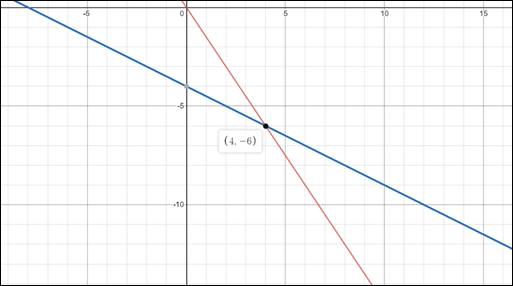
(a)
The system of equation need to solve by using the substitution method is to be described.
(a)
Answer to Problem 1RCC
Substitution method is nothing but a method to solve the value of one variable with the help of another variable of system of equation.
Explanation of Solution
If in the system of equations, there are two variables are used and they said that need to solve the system of equations with the help of the substitution method then one need to rewrite the one equation out of two to get one variable value.
Then put this variable value into the second eq. then the new eq. will find which is used to find another value of second variable. Now, you will get the exact value of the second variable, use it to find the first variable.
For example:
The given eqns. are:
Put the value of
Now, to find the value of
So, the solutions of given set of eqns. is
Conclusion:
Hence, the solutions of given set of eqns. is well described with the substitution method.
(b)
The system of equation need to solve by using the elimination method is to be described.
(b)
Answer to Problem 1RCC
You have to use either addition or subtraction to find the value of one variable and then use this value of one variable to get value of another variable in the elimination method.
Explanation of Solution
If in the system of equations, there are two variables are used and they said that need to solve the system of equations with the help of the elimination method thenyou have to use either addition or subtraction to find the value of one variable.
Then use this value of one variable to get value of another variable in the elimination method for the given system of equations.
For example:
The given eqns. are:
Multiply by
Take the subtraction of eqns. (3) and (2):
Now, to find the value of
So, the solutions of given set of eqns. is
Conclusion:
Hence, the solutions of given set of eqns. is well described with the elimination method.
(c)
The system of equation need to solve by using the graphical method is to be described.
(c)
Answer to Problem 1RCC
Graph both equations using either pencil-paper or graphing calculator in the same co-ordinate plane, the intersection point of the equations is nothing but the solution of the system of equation.
Explanation of Solution
If the system of two equations needs to solve by the graphically method then firstly need to write the given equations in the form of slope intercept.
The slope intercept form is given as:
Where,
Slope:
After that; just draw the graphs of equation by using the graphing calculator or paper −pencil based on your choice.
Now the cases of solution in the graphically method is as:
When the graph line of two equations intersects at a point then one can say that the system of eq. has one solution.
When the graph line of two equations is parallel then one can say that the system of eq. has no solution.
When the graph line of two equations is same then one can say that the system of eq. has infinitely much solution.
For example:
The given eqns. are:
Need to write the given eq. in the slope intercept form:
Since the slopes are different, the lines must intersect at a point. Here are the graphs of the both eqns:
So, the given set of system has one solution as

Conclusion:
Hence, the solutions of given set of eqns. is well described with the graphical method.
Want to see more full solutions like this?
Chapter 10 Solutions
Precalculus: Mathematics for Calculus - 6th Edition
- Please focus on ix.arrow_forwardPlease focus on vi.arrow_forward的 v If A is an n x n matrix that is not invertible, then A. rank(A) = n C. det(A) = 0 B. Reduced row-echelon form of A = In D. AB BA= In for some matrix B 63°F Partly sunny Q Search 3 $ 4 40 FS 96 S W E A S T FG S Y & コ B ㅁ F G H J 4 Z X C V B N M 9 H V FIB - FIB ㅁ P L ว DELETE BACHSPACE LOCK L ? PAUSE ALT CTRL ENTER 7 2:20 PM 4/14/2025 HOME J INSERT SHIFT END 5arrow_forward
 Calculus: Early TranscendentalsCalculusISBN:9781285741550Author:James StewartPublisher:Cengage Learning
Calculus: Early TranscendentalsCalculusISBN:9781285741550Author:James StewartPublisher:Cengage Learning Thomas' Calculus (14th Edition)CalculusISBN:9780134438986Author:Joel R. Hass, Christopher E. Heil, Maurice D. WeirPublisher:PEARSON
Thomas' Calculus (14th Edition)CalculusISBN:9780134438986Author:Joel R. Hass, Christopher E. Heil, Maurice D. WeirPublisher:PEARSON Calculus: Early Transcendentals (3rd Edition)CalculusISBN:9780134763644Author:William L. Briggs, Lyle Cochran, Bernard Gillett, Eric SchulzPublisher:PEARSON
Calculus: Early Transcendentals (3rd Edition)CalculusISBN:9780134763644Author:William L. Briggs, Lyle Cochran, Bernard Gillett, Eric SchulzPublisher:PEARSON Calculus: Early TranscendentalsCalculusISBN:9781319050740Author:Jon Rogawski, Colin Adams, Robert FranzosaPublisher:W. H. Freeman
Calculus: Early TranscendentalsCalculusISBN:9781319050740Author:Jon Rogawski, Colin Adams, Robert FranzosaPublisher:W. H. Freeman
 Calculus: Early Transcendental FunctionsCalculusISBN:9781337552516Author:Ron Larson, Bruce H. EdwardsPublisher:Cengage Learning
Calculus: Early Transcendental FunctionsCalculusISBN:9781337552516Author:Ron Larson, Bruce H. EdwardsPublisher:Cengage Learning





